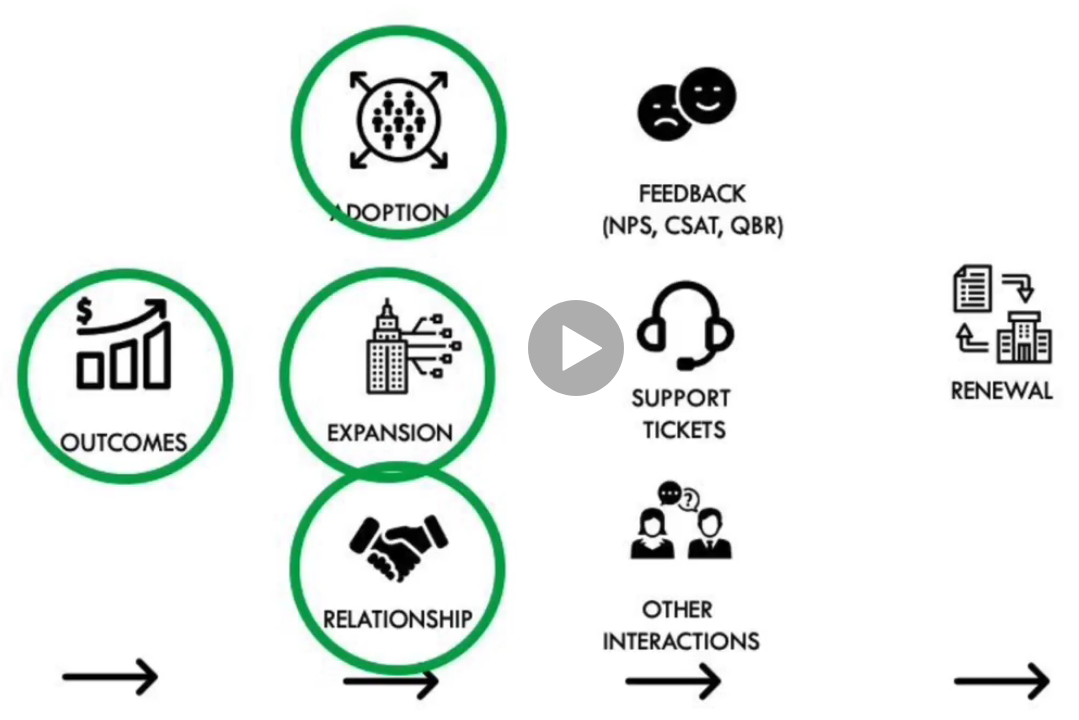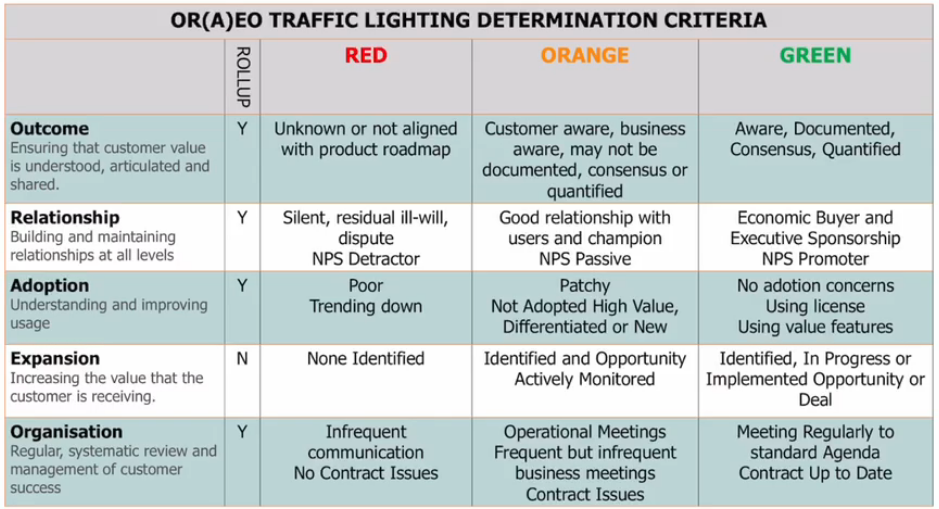< 4 Customer Success Foundations | Home | 6 Customer Success Framework >
27% Complete
15. Introduction to Measuring Health
https://www.udemy.com/course/essential-customer-success/learn/lecture/20243938#content
- Might also tell me if there are long term possibilities
- Sales
- Products
- Support
Typical CSM might be asked about the health of the customer
16. The Proactive CSM
https://www.udemy.com/course/essential-customer-success/learn/lecture/20766792#content
Which customer has my focus today?
- An unhealthly customer?
- Has an urgent issue
- Upcoming renewal 30 days out
- Had reminders at 60 and 90 days but too busy
- Friendly, happy customer
- Renewal pretty much in the bag
- These often take the most time
A Better Way
- Proactive tracking of customer health
- A basic understanding of leading and lagging indicators
- Systematic and routine assessment
- A transparent and shared approach to traffic lighting
- Rolling up to overall health
17. Proactive Health Perspectives
https://www.udemy.com/course/essential-customer-success/learn/lecture/20818966#content
How to proactively measure customer health
- Start with the end in mind and work backwards
- Renewal – End Goal
- Leading indicators
- Customer feedback
- Voice of the Customer (NPS)
- Feedback from the last QBR
- Support tickets
- How many are there?
- How many are escalated?
- Are well are the escalated tickets getting managed
- Are these critical to the customer’s business
- Other issues?
- Billing / Invoice issues?
- Others
- Leading indicators
- Renewal – End Goal
- Leading indicators to the leading indicators (Remember, I am working backwards)
- Adoption: Successful implementation of the service
- Is it regularly being used by all persons?
- Expansion
- Was it so successful they are expanding it to other departments
- Relationship: How is the relationship between all stakeholders?
- I might have a great relationship with the customer champion, but what about others?
- A new Manager that used a competetive product at previous company
- Do we know who the decision maker is when it comes to to renewals
- I might have a great relationship with the customer champion, but what about others?
- Adoption: Successful implementation of the service
- The Leading, Leading, Leading indicator:
- My customers’ business outcome
- If my services is essential to them
- winning new customers
- staying ahead of the competition
- Maintaining compliance with a governing body
- Any of these can be a strong indicator of relationship health
- If my business is essential to their success, the needle starts in the Green and should stay healthy
- If my services is essential to them
- My customers’ business outcome
Review
- Desired outcome is renewal (Retain the business)
- 4 Indicators
- Adoption: Are they regularly and routinely using the service
- Expansion: Are they getting so much value they are expanding to new teams
- Relationship: How is it, really?
- Customer’s Business outcome
If we track, measure, asses and respond to these 4 perspectives, we take all the guess work out of renewals. All that remains is a systematic way of assessing each of these.
18. Traffic Lighting Introduction
https://www.udemy.com/course/essential-customer-success/learn/lecture/20915818#content
19. Traffic Light Laws
https://www.udemy.com/course/essential-customer-success/learn/lecture/20915898#overview
Along with the 4 perspectives, Outcomes, Adoption, Expansion and Relationships, add a 5th:
- Organized: An internal perspective
With these we need a systematic way of assessing and measuring each of these.
- Lagging indicators are generally Quantitative, easy to measure
- Leading indicators are often both Quantitative and Qualitative.
- These will require some math and some judgement to assess
- Also need to represent the state of these unambiguously so is clear to the team and others.
- Introduce the Traffic Lighting System
- Green – Everything is OK
- Yellow – Things may be OK, but may require additional monitoring
- Red – Negative
To define the Traffic Light Status as objective as possible, we implement the following laws:
- Determination Criteria for calculating Green, Yellow and Red
- The determination criteria is documented.
- Green status requires no exceptional action
- This should only require the standard routine actions.
- Yellow and Red require an Action Plan… always.
20. Traffic Lighting Determination Criteria
https://www.udemy.com/course/essential-customer-success/learn/lecture/20915940#overview
Determination criteria is qualitative, but justifiable, for indicating the status of my customers as Green, Yellow or Red.
- Green
- All is good
- No issues
- No corrective Action
- Carry on being successful (current course and speed)
- Yellow
- Generally OK
- There is a risk or issue that while not currently urgent, might become so.
- Requires an action plan
- Visible, but proactive communication is not necessary
- Red
- There is an issue or problem.
- Urgent or Severe
- It requires investigation and a plan of action
- It should be tracked
- Everyone should be aware proactively.
Applying Traffic Light Laws to the 5 Perspectives
- Outcome: Ensuring the customer value is understood, articulated (easy to explain and possibly quantifiable) and shared.
- Red
- Value is unknown.
- Is known, but not be aligned with the service roadmap.
- Yellow (Risk)
- Customer is aware of a risk, or if I am aware of a risk, but we don’t really talk about it.
- Outcome is not documented
- No concensus or not quantified
- Green
- Customer is aware of the outcome
- I am aware of the outcome
- Everything is documented
- Full Concensus
- Quantified
- Red
- Relationship – What is the status of the relationship with the customer and likelyhood we can maintain it as it is.
- Red
- Silent – Lack of communication
- Residual ill-will
- Dispute
- NPS Detractor (key contact?)
- Yellow
- One of the stakeholders is Passive
- NPS Passive
- Green
- All Promotors
- Red
- Adoption – Confidence the service is used regularly and in a way that delivers the most value.
- Red
- Low usage relative to licenses
- Usage trending down
- Yellow
- Patchy usage – Some segments use it, others not so much
- Not using features that are known to deliver a lot of value.
- Not using differentiated features that are unique to our product that give us a competitive edge
- Not adopting to the new features. This might suggest they are not fully integrated.
- Green
- No adaption concerns
- Using licenses
- Using value
- Using differentiating features
- Using new features.
- Red
- Expansion – Opportunities to increase the value that the customer is receiving
- Red
- None identified
- Use a gap analysis tool?
- None identified
- Yellow
- Opportunity has been identified and logged, but no clear next step.
- Opportunity is not progressing
- Green
- Identified
- Opportunity created and progressing
- Recently implemented expansion
- Red
- Organization – Are we organized effectively to manage our customer, or are they organized effectively to manage us?
- Red
- Communication is infrequent
- Customer does not/cannot make time for calls.
- Contact issues
- Customer says the do not want them
- Customer wants to reduce frequency to something more manageable.
- Admin or contract issues
- Communication is infrequent
- Yellow
- Customers are attending Operational Meetings
- but not representing during Business meetings
- or Commercial meetings (Actual buying or selling)
- Issues with other corporate agreements
- Issues with a framework
- Something Global, standard or fixed and your contacts are unable to affect change or their legal teams are unwilling.
- These are “Take it or Leave it” supplier agreements common in very large businesses.
- Customers are attending Operational Meetings
- Green
- Attending Operational meetings
- Attending Business meetings
- Attending Commercial meetings
- QBRs Quarterly Reviews, which include
- updates from the customer about their business
- Updates from me about mine and my people
- Contracts and agreements are all up to date, agreed and signed.
- Red
Overall Assessment Traffic Light
At what point does a Yellow or Red in one of the 5 perspectives roll up to a Red or Yellow overall?
- Any Red or Yellow in Outcome, Relationship, Adoption or Organization should become the Overall Score.
- A Red or Yellow in Expansion should NOT become the overall score (generally)
- For some solutions in some markets, this might not be the case.
OR(A)EO (Adoption stuffed Oreo)
Quiz 2: Customer Health Quiz
https://www.udemy.com/course/essential-customer-success/learn/quiz/4957518#overview
1. As a CSM you should focus your time on which type of customer?
- Those that have a problem
- Those that have been great reference cosutmers, speak at user conferences and commit to meeting regularly
- Those that have identified health issues.
- Proactively measuring health means that you can focus a proportion of your time on those that are unhealthy but are not creating immediate issues whilst still leaving time for customers that have urgent and pressing issues
2. Which of the following is NOT a health dimension?
- Relationship
- NPS
- Customer satisfaction or Net Promoter Score may be a leading indicator of renewal but it is not a health dimension
- Expansion
- Outcome
3. Which of the following is NOT a leading indicator of health and likely renewal?
- Adoption
- Expansion
- Outcome
- The customer spoke at our user conference this year
- This may be an indication of a healthy relationship which may then, in turn be a leading indicator but we would need to assess the relationship more fully.
4. Which of the following is true about traffic lighting determination criteria?
- It should be made available to the customer success team only
- The overall assessment is rolled up from the Outcome, Relationship, Adoption and Organization perspective
- A red or amber in any one of those four perspectives would roll up to the overall assessment. Generally, a red or amber in the Expansion perspective would not rollup to the overall assessment
- Because the Organization perspective is different, this does not get traffic lighted.
5. What is the most leading indicator of health
- Outcome
- Outcome is the most leading indicator. Like all leading indicators, it does not guarantee a successful outcome but it is far more likely for a customer to be retained if their outcome is clear, agreed upon, connected to a value driver and quantified
- Adoption
- Expansion
- Relationship

